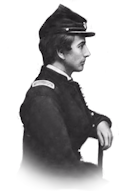 April 14th. Another fine morning. After an hour of orderly room work, I took a long walk with Doctor McKim to the beach, where we were greatly interested in the disembarkation of troops, horses and big guns. We also met several officers, from whom we got a good deal of gossip; amongst other things it is said that if McClellan had pushed forward the troops as soon as they were landed, he might easily have taken Yorktown, and saved the tedious and expensive operations of a regular siege. He is much criticised for his lack of dash and enterprise, and there are many who doubt already his ability as a general commanding.
April 14th. Another fine morning. After an hour of orderly room work, I took a long walk with Doctor McKim to the beach, where we were greatly interested in the disembarkation of troops, horses and big guns. We also met several officers, from whom we got a good deal of gossip; amongst other things it is said that if McClellan had pushed forward the troops as soon as they were landed, he might easily have taken Yorktown, and saved the tedious and expensive operations of a regular siege. He is much criticised for his lack of dash and enterprise, and there are many who doubt already his ability as a general commanding.
It seems the enemy have established an irregular line extending from the York to the James river, their left resting on Yorktown, and right on Mulberry Island, in rear of the river Warwick, which takes its rise about three miles from Yorktown and flows thence into the James. This rather small stream has been made a formidable barrier by means of dams, thus raising the water and making it unfordable. Its banks are swampy woods, impassable for guns and wagons, and so constitutes a formidable defensive work. Yorktown is on high rolling ground and capable of making a good defense with the works already built. It is strongly supported as well as commanded by heavy forts at Gloucester on the opposite shore of the York river, whose guns, we are told, are powerful enough to prevent all the fleets of the United States from passing up the river. General Magruder, the rebel commander, had less than twenty thousand men when we first landed. As we had at least fifty to seventy-five thousand men the second day of our arrival, it is easy to see we could have entirely overwhelmed them if McClellan had been more enterprising.
The army is posted as follows: Heintzlemen on the right, Sumner in the center, and Keys on the left. General Fitz John Porter is director of the siege, General Barry, chief of artillery, and General Barnard, chief of engineers. Lines of investment have been laid out, and much work done. Heavy mortars, some of them throwing a shell two feet in diameter; siege Parrot guns and big howitzers are being mounted in batteries and will soon be ready to open fire. Our division, is in reserve and occupied almost exclusively in building docks and roads, but the work is very nearly finished, and then we shall take our turn in the works.


